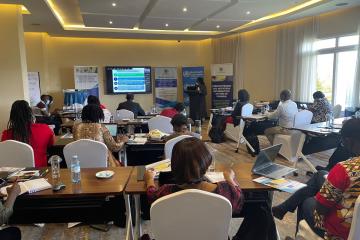—
Nearly all trial participants had some level of immunity at baseline, however
by
Katherine Kahn,
Staff Writer, MedPage Today
July 17, 2024
Nirmatrelvir-ritonavir (Paxlovid) did not prevent people exposed to COVID-infected household members from getting infected with the virus, according to the final results of the phase II/III EPIC-PEP study.
Across more than 2,700 exposed adults in the trial, symptomatic confirmed infections at 14 days occurred in 2.6% of those taking a 5-day course of the antiviral medication, 2.4% of those receiving a 10-day course, and 3.9% of the placebo recipients. Neither of those differences versus the placebo group were statistically significant (P=0.17 and P=0.12, respectively), reported Jennifer Hammond, PhD, head of antiviral development at Pfizer in Collegeville, Pennsylvania, and colleagues.
Asymptomatic infections developed in about 2% of participants in the 5- and 10-day nirmatrelvir-ritonavir groups versus 3.1% of the placebo group, but again the differences were not statistically significant, the researchers detailed in the New England Journal of Medicine.
“The secondary attack rate among household contacts of individuals infected with the Omicron variant is estimated to be up to 81%,” Hammond and researchers wrote in the study’s supplementary material. “Currently, postexposure prophylactic treatment for house contacts of SARS-CoV-2-infected individuals is not available, although such an approach is recommended in other infectious disease settings.”
Currently, nirmatrelvir-ritonavir is FDA approved only as a 5-day regimen for treating adult outpatients with mild-to-moderate COVID-19 who are at risk for severe disease.
Hammond’s team determined that the incidence for the development of symptomatic COVID-19 by day 14 among participants at high risk for severe disease did not differ significantly between the groups. And, in a subgroup analysis, no difference was noted in outcomes during periods when the Delta or Omicron variant predominated.
The study’s final results come on the heels of the EPIC-SR trial, which found that nirmatrelvir-ritonavir failed to shorten illness duration as a treatment for COVID-19 in standard-risk and vaccinated at-risk patients. However, a subgroup analysis of that study found that the antiviral is still likely to keep higher-risk patients from developing severe disease. The earlier EPIC-HR trial found that unvaccinated, high-risk patients were significantly less likely to die or be hospitalized if they took nirmatrelvir-ritonavir, which supported the drug’s 2023 approval.
In the EPIC-PEP trial, 91% of participants were seropositive for SARS-CoV-2 at baseline, most likely a result of previous infection or vaccination, Hammond and authors noted. “It is not known whether the high baseline seropositivity rates observed in this trial led to the lower-than-expected rates of household transmission,” they wrote. About 13% in all three groups had received one or more doses of a COVID-19 vaccine.
Among participants seropositive at baseline, confirmed COVID-19 developed by day 14 in 2.2% and 2.0% in the 5- and 10-day nirmatrelvir-ritonavir groups and 3.6% in the placebo group. The between-group differences were not statistically significant.
Viral loads decreased over time among participants with a positive SARS-CoV-2 test across all groups. One participant each (2.6% and 2.1%) in the 5- and 10-day prophylaxis groups experienced a rebound in viral load. None of those in the placebo group had a viral load rebound.
The most common treatment-related adverse event in the nirmatrelvir-ritonavir prophylaxis groups was mild-to-moderate alterations in taste or metallic taste. Nausea and diarrhea occurred in at least 1% of prophylaxis recipients, with most events being mild.
Of note, the 10-day regimen had a similar safety profile to the shorter regimen. This may be important because in regards to treatment of confirmed COVID-19 with nirmatrelvir-ritonavir, “longer treatment durations are being explored in some patient populations,” the authors wrote.
The trial took place from September 2021 to April 2022. Researchers randomized 921 participants to the 5-day nirmatrelvir-ritonavir group, 917 to the 10-day group, and 898 to the placebo group. About 21% underwent randomization before Dec. 20, 2021. Median age was 43 years, and 47% were men. Over 70% of participants had coexisting medical conditions putting them at risk for severe COVID-19. Adherence to assigned regimens was about 95% across the three trial groups.
COVID-19 infection was confirmed by reverse-transcriptase-polymerase-chain-reaction (RT-PCR) or rapid antigen testing in all groups. All participants in the primary analysis of the study tested negative for COVID-19 on RT-PCR or rapid antigen testing at baseline.
Limitations of the study include limited effectiveness of the blinding due to the distinctive taste of nirmatrelvir-ritonavir, the lack of detailed data on index patients since they are not direct participants in the trial and did not consent to provide information, and a potential effect from other infected household members.
![author['full_name']](https://assets.medpagetoday.net/media/images/author/2N5A0622_180.jpg)
Katherine Kahn is a staff writer at MedPage Today, covering the infectious diseases beat. She has been a medical writer for over 15 years.
Disclosures
The study was funded by Pfizer.
Hammond and other study authors are employees of Pfizer. One study author reported additional ties to industry.
Primary Source
New England Journal of Medicine
Source Reference: Hammond J, et al “Oral nirmatrelvir-ritonavir as postexposure prophylaxis for Covid-19” N Engl J Med 2024; DOI: 10.1056/NEJMoa2309002.
Note: This article have been indexed to our site. We do not claim legitimacy, ownership or copyright of any of the content above. To see the article at original source Click Here













